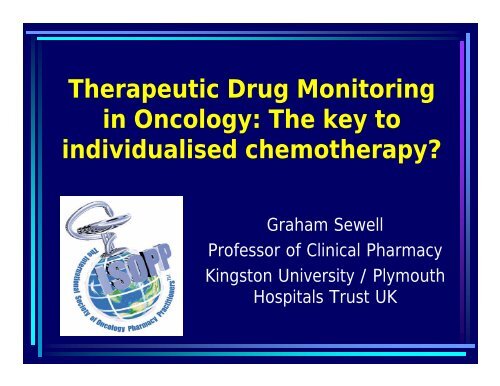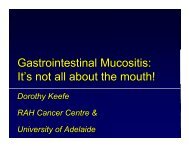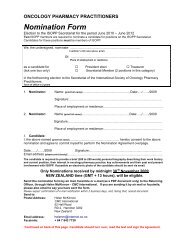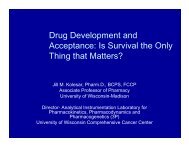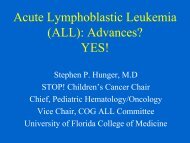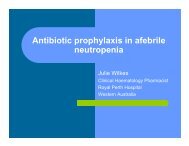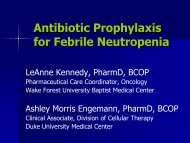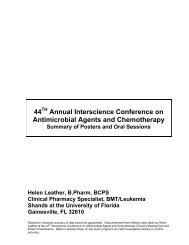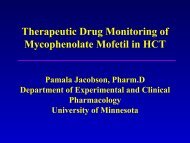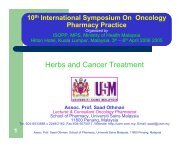Therapeutic Drug Monitoring in Oncology: The key to individualised ...
Therapeutic Drug Monitoring in Oncology: The key to individualised ...
Therapeutic Drug Monitoring in Oncology: The key to individualised ...
You also want an ePaper? Increase the reach of your titles
YUMPU automatically turns print PDFs into web optimized ePapers that Google loves.
<strong><strong>The</strong>rapeutic</strong> <strong>Drug</strong> <strong>Moni<strong>to</strong>r<strong>in</strong>g</strong><br />
<strong>in</strong> <strong>Oncology</strong>: <strong>The</strong> <strong>key</strong> <strong>to</strong><br />
<strong>in</strong>dividualised chemotherapy?<br />
Graham Sewell<br />
Professor of Cl<strong>in</strong>ical Pharmacy<br />
K<strong>in</strong>gs<strong>to</strong>n University / Plymouth<br />
Hospitals Trust UK
Contribution of Chemotherapy <strong>to</strong> 5<br />
year survival <strong>in</strong> adult malignancies<br />
• 5-year survival rate (1992-97) for 22 adult<br />
malignancies <strong>in</strong> Australia = 63.4% (CI 95 63.1-<br />
63.6)<br />
• Contribution of “curative and adjuvant”<br />
chemotherapy = 2.3% (USA = 2.1%)<br />
• Ma<strong>in</strong> role of chemotherapy is palliation<br />
Morgan G et al Cl<strong>in</strong>ical <strong>Oncology</strong> (2004) 16, 549-560<br />
• Many reasons for chemotherapy failure<br />
<strong>in</strong>clud<strong>in</strong>g drug resistance and sub-optimal<br />
dosage schedules
Cancer Chemotherapy<br />
• High <strong>to</strong>xicity<br />
• Low efficacy<br />
• Inter-patient variability<br />
• Narrow therapeutic w<strong>in</strong>dow<br />
• Dos<strong>in</strong>g usually based on avoidance of<br />
<strong>to</strong>xicity rather than on ensur<strong>in</strong>g<br />
efficacy.<br />
• Need for therapeutic optimisation
Presentation Outl<strong>in</strong>e<br />
• TDM <strong>in</strong> Pharmacotherapy<br />
• Dose determ<strong>in</strong>ation <strong>in</strong> cancer<br />
chemotherapy<br />
• Use of TDM <strong>in</strong> chemotherapy:<br />
- Opportunities<br />
- Limitations and challenges<br />
• TDM <strong>in</strong> chemotherapy: Future<br />
developments
Pharmacok<strong>in</strong>etics<br />
• Describes the process of drug absorption,<br />
distribution and elim<strong>in</strong>ation<br />
• Key terms: Bioavailability (F)<br />
Volume of Distribution (Vd)<br />
Prote<strong>in</strong>-b<strong>in</strong>d<strong>in</strong>g<br />
Clearance (Cl)<br />
Half –Life (T1/2)<br />
Area Under Cp Vs time curve (AUC)
Cl<strong>in</strong>ical Pharmacok<strong>in</strong>etics<br />
• Many drug doses are empirical<br />
• <strong>Drug</strong> elim<strong>in</strong>ation (and hence efficacy<br />
and <strong>to</strong>xicity) varies between patients.<br />
• Body wt. and BSA – not always good<br />
<strong>in</strong>dica<strong>to</strong>rs of drug clearance<br />
• Some drugs have narrow therapeutic<br />
w<strong>in</strong>dow E.g. cy<strong>to</strong><strong>to</strong>xic drugs used <strong>in</strong><br />
cancer chemotherapy
<strong><strong>The</strong>rapeutic</strong> <strong>Drug</strong> <strong>Moni<strong>to</strong>r<strong>in</strong>g</strong><br />
(TDM)<br />
• Large variation <strong>in</strong> drug plasma<br />
concentration between <strong>in</strong>dividuals for a<br />
given dose;<br />
Formulation<br />
<strong>Drug</strong> <strong>in</strong>teractions<br />
Life-style (eg diet, smok<strong>in</strong>g)<br />
Disease (renal & hepatic function)<br />
Genetic variation (<strong>in</strong> metabolism)
Cl<strong>in</strong>ical Use of TDM<br />
• Measure plasma concentration of drug <strong>to</strong><br />
adjust dose for <strong>in</strong>dividual :<br />
- maximises therapeutic effect<br />
- m<strong>in</strong>imises drug – related <strong>to</strong>xicity<br />
• Moni<strong>to</strong>rs on-go<strong>in</strong>g therapy<br />
• Checks patient compliance and<br />
adm<strong>in</strong>istration of medic<strong>in</strong>es <strong>to</strong> the patient
Requirements for TDM<br />
• No direct cl<strong>in</strong>ical measure <strong>to</strong> provide clear<br />
evidence of drug therapeutic effect or drug<br />
<strong>to</strong>xicity (or multiple <strong>to</strong>xicities)<br />
• <strong>Drug</strong> plasma concentration is related <strong>to</strong> either<br />
therapeutic or <strong>to</strong>xic effect<br />
• <strong>Drug</strong> has low therapeutic : <strong>to</strong>xicity ratio<br />
• <strong>Drug</strong> is used as prophylactic (eg. Pheny<strong>to</strong><strong>in</strong>)<br />
• <strong>Drug</strong> is not extensively metabolised <strong>to</strong> active<br />
metabolites
Medic<strong>in</strong>es Moni<strong>to</strong>red by TDM<br />
Digox<strong>in</strong> Pheny<strong>to</strong><strong>in</strong> Carbamazep<strong>in</strong>e<br />
Cyclospor<strong>in</strong> Gentamic<strong>in</strong> Lithium<br />
<strong>The</strong>ophyll<strong>in</strong>e Vancomyc<strong>in</strong> Valproate<br />
Amiodarone Phenobarbi<strong>to</strong>ne
TDM : Procedure<br />
• Take sample: - correct time<br />
- correct sample tube<br />
- correct state (plasma or<br />
serum)<br />
• Measure concentration (RIA, HPLC etc)<br />
• Interpret concentration and consider<br />
confound<strong>in</strong>g fac<strong>to</strong>rs
Examples of Non-<strong>Oncology</strong> TDM<br />
“therapeutic range”<br />
• Digox<strong>in</strong>; 1 – 3.8 nmol/L (gives therapeutic<br />
effect – avoids ADR’s of malaise,<br />
anorexia,vomit<strong>in</strong>g,confusion)<br />
• Gentamic<strong>in</strong>; <strong>to</strong> achieve bactericidal effect<br />
m<strong>in</strong> plasma conc = 5ug/ml<br />
To avoid <strong>to</strong>xicity, max plasma conc =<br />
10ug/ml and max trough conc = 2ug/ml
TDM- “<strong>The</strong> Old Way”<br />
• Give standard dose<br />
• Check plasma level<br />
• React <strong>to</strong> plasma level<br />
• If high- lower the dose and re-check<br />
• If low- <strong>in</strong>crease dose and re-check<br />
• No differentiation between upper and<br />
lower ends of therapeutic range<br />
• Tend <strong>to</strong> “treat the level, not the patient”
Is Dose Important <strong>in</strong> Cancer<br />
Chemotherapy?<br />
• Yes – for <strong>to</strong>xicity<br />
• Yes for efficacy?????<br />
• Inter-patient variability<br />
• Bonadonna: Reduced survival <strong>in</strong> breast<br />
cancer patients receiv<strong>in</strong>g < 85% of<br />
target dose <strong>in</strong> CMF regimen<br />
Bonadonna etal, N Engl J Med (1995), 332, 901
How Accurate/Relevant is<br />
BSA-Based Dos<strong>in</strong>g ?<br />
• Use of BSA arises from <strong>in</strong>terspecies dos<strong>in</strong>g<br />
(animals <strong>to</strong> humans) <strong>in</strong> Phase 1 studies.<br />
• BSA does not correlate well <strong>to</strong> drug clearance<br />
plasma or tumour levels.<br />
• Errors <strong>in</strong> BSA calculation (DuBois and<br />
DuBois, Arch. Int.Med 1916 : 17 :863-71)<br />
• No basis for physiological scal<strong>in</strong>g with<strong>in</strong><br />
species
Further Read<strong>in</strong>g on BSA <strong>in</strong><br />
Cancer Chemotherapy<br />
• Reilly JJ, Workman P . Normalisation of<br />
anticancer drug dosage us<strong>in</strong>g body weight<br />
and surface area; is it worthwhile ? Cancer<br />
Chemotherapy and Pharmacology 1993, 32,<br />
411-418<br />
• Rata<strong>in</strong> MJ. Body surface area as a basis for<br />
dos<strong>in</strong>g of anticancer agents; science myth or<br />
habit. J Cl<strong>in</strong> Oncol 1998, 16, 2297-2298<br />
• Egor<strong>in</strong> M Edi<strong>to</strong>rial 2003, J Cl<strong>in</strong> Oncol, 21, 182
Problems with TDM <strong>in</strong> <strong>Oncology</strong><br />
• Plasma level does not reflect tumour level of<br />
drug or drug level <strong>in</strong> sensitive healthy tissues<br />
• Lag time between exposure of tumour <strong>to</strong><br />
drug and therapeutic effect<br />
• Often no clear relationship between Cp and<br />
<strong>to</strong>xicity/therapeutic effect<br />
• Tumours (and metastasis) are heterogenious
Examples of TDM (1)<br />
Methotrexate<br />
• High-dose MTX therapy<br />
• Moni<strong>to</strong>r plasma MTX 24-48 hours postdose<br />
• Fol<strong>in</strong>ic acid rescue until plasma level<br />
Examples of TDM (2)<br />
5-Fluorouracil<br />
• Colorectal cancer (<strong>in</strong> comb<strong>in</strong>ation)<br />
• Toxicity: Haema<strong>to</strong>logical and mucositis<br />
• Predicted <strong>to</strong>xicity if AUC > 30,000<br />
ug/L.hr<br />
Milano G et al, Int J Cancer (1988), 41, 537-541
2- 13 C-Uracil Breath Test<br />
• Estimates DPD activity<br />
• Give test dose of 2- 13 C-Uracil<br />
• Measure 13 CO 2 levels <strong>in</strong> exhaled breath<br />
• 13 CO 2 levels correspond <strong>to</strong> DPD activity<br />
• Can identify patients with DPD deficiency<br />
• Use these data <strong>to</strong> adjust and optimise 5-FU<br />
dose
Example of TDM (3)<br />
Mercap<strong>to</strong>pur<strong>in</strong>e<br />
• Children with ALL (repeated sampl<strong>in</strong>g)<br />
• Relapse associated with Cp max<br />
363ng/hr.ml<br />
Hayder S etal, <strong>The</strong>r drug Monit 1989, 11, 617-<br />
622
Genetic Polymorphisms <strong>in</strong><br />
Metaboliz<strong>in</strong>g Enzymes<br />
www.sciencemag.org/feature/data/1044449.shl<br />
Science 1999;286:487-91
Mercap<strong>to</strong>pur<strong>in</strong>e Catabolism<br />
Liver<br />
GI Tract<br />
Target Cell<br />
6-MP<br />
HGPRT<br />
TIMP<br />
TGTP<br />
TPMT<br />
Thiouric Acid<br />
Me-MP<br />
Me-TIMP<br />
Catabolism
TDM <strong>in</strong> <strong>Oncology</strong>: Confound<strong>in</strong>g<br />
Fac<strong>to</strong>rs<br />
• Genetic polymorphism<br />
• <strong>Drug</strong> resistance<br />
• <strong>Drug</strong> <strong>in</strong>teractions<br />
• Assay difficulties<br />
• Active metabolites<br />
• Some drugs are pro-drugs (e.g.<br />
cyclophosphamide)
PK-PD Relationships <strong>in</strong> Cancer<br />
Chemotherapy<br />
• Difficult <strong>to</strong> select a reliable and relevant<br />
PD measure<br />
• PD measure is usually a <strong>key</strong> <strong>to</strong>xicity<br />
• Case Study: Change of schedule of<br />
Carboplat<strong>in</strong> from short-<strong>in</strong>fusion <strong>to</strong><br />
prolonged cont<strong>in</strong>uous <strong>in</strong>fusion
PK-PD Relationship <strong>in</strong> change of<br />
Schedule<br />
• Example:<br />
Carboplat<strong>in</strong> by short IV <strong>in</strong>fusion<br />
Change <strong>to</strong>:<br />
Carboplat<strong>in</strong> by prolonged cont<strong>in</strong>uous<br />
<strong>in</strong>fusion (+RT)
Carboplat<strong>in</strong> dose for manageable<br />
haema<strong>to</strong>logical <strong>to</strong>xicity<br />
Dose(mg) = Target AUC x (GFR + 25)<br />
(Calvert Equation)<br />
Target AUC values;<br />
4 - 6 mg.ml/m<strong>in</strong> (pre-treated patients)<br />
6 - 8 mg.ml/m<strong>in</strong> (untreated patients)
Carboplat<strong>in</strong> cont<strong>in</strong>uous <strong>in</strong>fusion with<br />
Synchronous Radiotherapy<br />
Carboplat<strong>in</strong> 25-40mg/day x 5days x 4<br />
courses<br />
by cont<strong>in</strong>uous <strong>in</strong>fusion + radiation (40Gy) ,<br />
fractionated
Carboplat<strong>in</strong> Cont<strong>in</strong>uous Infusion PK-<br />
PD Study: Conclusion<br />
• Dose – GFR relationship for short-<strong>in</strong>fusion of<br />
carboplat<strong>in</strong> is not valid for prolonged <strong>in</strong>fusion<br />
• PK-PD relationship for prolonged <strong>in</strong>fusion<br />
enables dose calculation from pre-treatment<br />
platelet count.<br />
• <strong>The</strong> PK-PD model ensures maximum dose –<br />
<strong>in</strong>tensity, but with acceptable <strong>to</strong>xicity.<br />
Allsopp and Sewell, Journal <strong>Oncology</strong> Pharmacy Practice<br />
(1995), 1 (3), 23-32
TDM – <strong>The</strong> New Way<br />
• Collect <strong>in</strong>formative data, apply <strong>to</strong> Baysian<br />
models (model “learns” from this)<br />
• Identify central tendency and dispersion of<br />
pk parameters.<br />
• Identify useful co-variates (BSA, GFR etc)<br />
• Apply Bayesian adaptive control strategy<br />
• Predict outcome and Control therapy
Bayesian <strong>The</strong>ory<br />
Rev. Thomas Bayes, 1702 - 1762<br />
• Maximal a posteri Bayesian estimation<br />
• Dose adjustment based on most relevant<br />
exposure <strong>in</strong>dex (Cp, Cp max , AUC etc)<br />
• Estimates made for each patient us<strong>in</strong>g<br />
limited <strong>in</strong>dividual data (demographic,<br />
cl<strong>in</strong>ical, [drug], pharmacogenomic, etc)
Bayesian Adaptive Dose<br />
Bayesian<br />
Approach:<br />
Prior<br />
probability<br />
New Info<br />
Objective<br />
function<br />
Posterior<br />
probability<br />
Goals<br />
Control<br />
therapy<br />
In<br />
Practice:<br />
Population<br />
model<br />
<strong>Drug</strong><br />
levels<br />
Prior +<br />
New <strong>in</strong>fo.<br />
Individual<br />
model<br />
Patient<br />
specific<br />
Calculate<br />
dose
Bayesian Adaptive Dos<strong>in</strong>g<br />
Prospective Review<br />
Genetic Fac<strong>to</strong>rs for <strong>Drug</strong> Disposition<br />
/Response/Toxicity<br />
Test – dose TDM<br />
Conventional Medication Review<br />
Patient Specific Fac<strong>to</strong>rs (eg organ function,drug –<br />
drug <strong>in</strong>teractions, cautions, life-style <strong>in</strong>fluences etc<br />
etc)<br />
Comb<strong>in</strong>ation = Optimal Pharmacotherapy?
Conclusions<br />
• Expectation of TDM + other parameters<br />
for reduced <strong>in</strong>ter-patient variability and<br />
reduced <strong>to</strong>xicity and improved efficacy.<br />
• Little evidence that TDM actually<br />
achieves this.<br />
• Need large, prospective Phase III<br />
studies us<strong>in</strong>g Bayesian approach


